We as a nation did not create any licensable know how till date for mass production technology in chemicals manufacturing for worldwide sale
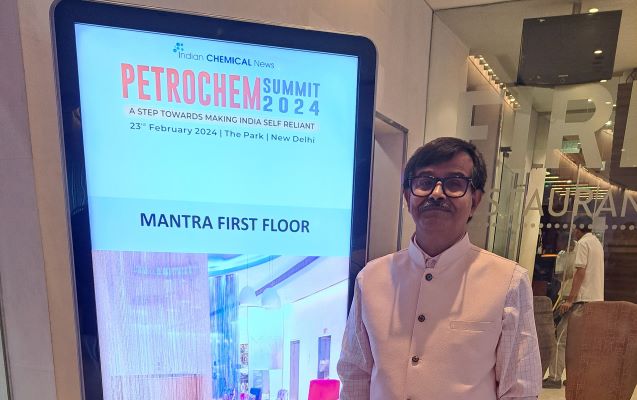
We are in the age of distraction because it is easy to reach there. We lost solitude, peace from our life because creating noise for disbalancing act for society is easier to do. It goes well with the 3rd law of thermodynamics; chaos, noises are the measures of randomness and its raise is a natural process. If we go back to our history in Vedic age – we see Rishis’, Saints’ and Guru were living in Ashrama-griha, in caves, in mountains and in Himalayas. Naturally they were extremely quiet, decent, calm, patient, highly spiritual oriented and hence they could keep them away from all sorts of chaos, noise, distraction etc. which we cannot avoid today. Hence lifestyle in Vedic era made Indian rich in every-spheres we can think of today, made India enormously rich in science, culture, wealth, and well-being of people. Inventions in that era are still contemporary in today’s most difficult domain e.g chanting of ‘OM’ resembles the sound of sun discovered by NASA very recently which Indian knew for ages and hence they made chanting of ‘OM’ in their daily routine to purify mind and soul.
Second, world has acknowledged India’s Vedic-science led knowledge in ancient time gave birth to many foundational scientific break-through led to superior interpretation of cosmos, development of medicine & surgery, sound design practices in architecture planning & building construction etc. which later rest of the world put their resources together, cultivated more to apply them in modern settings and made phenomenal progress in Science & Technology from the rich scientific know-hows’ written in Vedic language in that era. Despite having rich foundational knowledge, India failed to maintain its pace of scientific development after independence when lifestyle changes were happening calling for advanced application of chemicals were growing for day-to-day needs. India failed to acknowledge this national importance necessitating self-sufficiency in chemicals manufacturing in India, did not allocate resources to Scientists & Engineers for discovery, creation of technologies made for India and eventually fall behiend in technology led growth.
It is customary for us to know that in pre-independent India, our visionary scientist and an entrepreneur, Dr. Acharya P.C. Ray, felt the necessity of chemicals for human society and built the Bengal Chemicals factory in 1901 based on indigenous technology he created ahead of many Asian nations. After independence there were multiple examples that India could have learned from Europeans, Japanese, Koreans, Latin American nations who were pursuing scientific development in building their own technologies got benefited economically by exporting chemical products & services, consistently earning revenues for their nation. Add to it other nations attained superior societal progress, enhanced per capita income in multifold and improved quality of life for their citizen.
Even today India needs to depend on imported product and services which citizens needed the most. This trend will continue forever unless we bring in big vision translated into reality in chemicals. We as a nation did not create any licensable know hows till date for mass production technology in chemicals manufacturing for worldwide sale. Therefore, larger opportunities lie ahead for India for setting for a harder vision with deep focus, build nationalistic goals on scientific capabilities by utilizing contemporary emerging technologies to create millions of jobs in coming decades.
Then one may ask why is this so important for a country like India having population of 1.4 billion where many competing priorities exists for the nation. An easy glimpse of statistics from US economy on two key areas taken from open source for the year ended in 2022 likely to throw some light in the direction we all like to see and know:
1.Gross value added from chemical business found to be 25.7% of GDP
2. Employment generation dependent on all sectors of chemicals is 26.9%.
Break-up of magnitude of economic value, employment generation figure is given below for taking a prospective view where the opportunity may lie for India in future. Though the context and GDP data, employment generation percentage arises out of chemicals cannot be compared with India as it is not available in the same plane but it can be said with certainty that the percentages for India will be much lower end, unmatched.
• Total value added from all sectors of US economy: 25463 billion USD
• Total industry depended on chemistry: 6532 billion USD
• Total employment for all sectors of US economy (in thousands): 149,987
• Total employment dependent on chemistry in US economy (in thousands): 40,417
• US nett. Export surplus on account of chemicals: 24.5 billion USD
It is evident from the global population forecast done, world population going to get multiplied from 7.58 billion from 2019 to 10 billion in 2055. It is also projected few Indian cities population will find in top-10 list surpassing many other nations. Hence India and its sub-continent needs to plan resources in advance, it would not be that easy to reach there with right mix of human capabilities but the population growth will reach the target. Therefore, advance planning in Science & Technology ought to be in place, try very hard to facilitate change to reach there. India’s domain expert will have to collaborate, engage in hard capability building, step-in in areas of combinatorial science which we do not know, cultivate expertise beyond syllabus, beyond text books of today. A fresh look on market share on top 10 countries shows where India stands on competition today (Ref. Fig-1).
EU27 market share dropped significantly
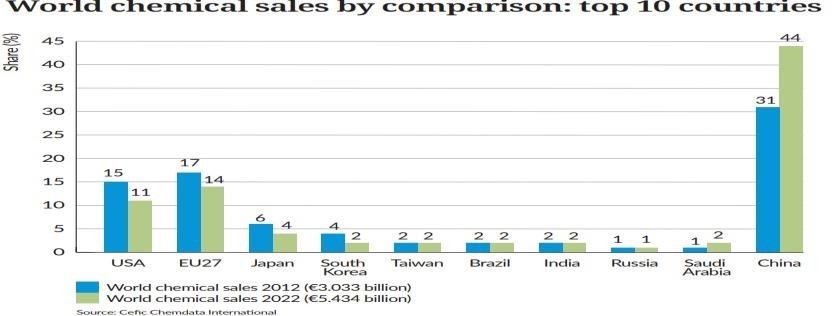
Fig -1: World chemicals sales comparison in 2012 vs 2022
Now let us explain how Chemistry of chemicals affect our day-to-day life on a spectrum of services we get and every person in acquainted with so that we can relate need and its importance easily. List below is for illustrative purposes, taking cues from them will mean a lot: Cleaning & disinfection, food & beverages, packaging, household appliances, medical supplies and equipment, modern communications, electronics, transportation, residential spaces, energy, pharmaceuticals, textile & apparels, covid response, building & construction, environment solutions, our protective gears (e.g. helmets, sports items, foot-ware), Paints & pigments etc.
Therefore, self-sufficiency in chemicals and its lineage to national economy for job creation, trade & commerce, know-hows’ creation that Indian to aim for indigenization now. For decades these segments were dominated by limited hi-tech ecosystem mainly from advanced economies of Europe, Japan, and Korea and lately China has joined in this club for couple of years. It is important to note that China has exceeded every other nation on manufacturing capabilities, built and delivered projects at a speed & scale and at a cost that o western country can match with them. This has resulted China to attain self-sufficiency, created surpluses and turned their economy into a net exporter on many chemicals, continues to occupy the leadership position in this decade and decades thereafter.
Recent disrupting trend necessitating to create chemical tech know-hows’ and indigenization of technology, building manufacturing capability in the country to supply chemicals directly to end user industries becoming a national agenda. Therefore, both the capacity and capability building roadmap on chemicals drawn the attention of legislators, policy makers for it to become a strategic importance in post covid era. This need has been further accentuated due to continuation of prolong war of Russia-Ukraine, potential war in West Asia, Red-sea crises coupled with geopolitical tensions, de-globalization leading to bilateral trades, political sanction on countries for isolation; all put together created a supply chain disruption causing major uncertainty to nonavailability of chemicals, created an imbalance and shortages of key chemicals that many allied industries depending on for more value-added manufacturing for Indian citizen and other parts of the world.
It is also to be noted that excepting commodity & specialty chemicals, India is a net-importer on segments like Intermediates, Bulk Chemicals (Inorganic & Organic), Fine Chemicals and Oleochemicalsand hence a burden on national economy which a country like India cannot afford for long. Material needs to life will undergo a major shift resulting from global warming causing business of chemistry to change significantly near future, with the pace of demographic changes happening in India this will affect Import bill to go up in multiples. It will be a blunder if India continues to hold on to traditional approaches what pushed India behind the competition from western world.
Going forward globally ‘Oil and Gas’ will be the seller’s market for decades for sure, prices will be based on demand supply being artificially created. This gap expected to be widened if the global worming issues are not addressed in time and the world will fall into energy demand trap where the supply will always be in shortage. Therefore, alternative solution lies to the rest of the world - only in off-setting them from devoid of petroleum use for fuel and power away from tradition, use them in converting into advanced materials necessitating from rising demand, set to go up in more in value added segment what the citizen of India should be looking for at an affordable cost.
While we agree that future is uncertain looking at trend what we see, let us imagine that the world of 2040 is deglobalized, the USA has lost its role as the global policeman and no other superpower has replaced it. Instead of a free world order, there is a conflict-laden multipolar order in which global challenges such as climate change are being inadequately addressed. China is setting the international agenda culturally, politically, militarily, and then advancing to environmental protection. It has built up its power and influence step by step, first in Asia, then westward along the new Silk Road all the way to Europe, and finally worldwide. By this time China has become a global superpower and every other nation are increasingly striving to promote their own interests.
In future, India will continue to be a petroleum resource deficit economy. As demand set to rise, it will raise its import bill, a hard reality that India must acknowledge. Till date India remains to be a commodity player, cannot compete with China, Gulf countries in commodity segment but strategically India needs to invest to attaining self-sufficiency keeping pace of change in
Demography. On top of it, there is a rapid polarization, shift in capital investment in chemicals manufacturing segment happening, also shift in investment in Research & Innovation(R&I) getting tilted heavily to China. Hence, there is an opportunity for Indian chemicals business to concentrate where Japan, Korea, Europe, Tiwan did few decades ago plus higher end products which India will be needing as part of Make-in-India campaign pushing its GDP growth upwards from domestic life style changes. The mandate is every product is to be manufactured in India, create surpluses for export. This requires tremendous focus and quantum jump in R&I expenditure keeping pace with China in magnitude to fulfill national dream in chemicals starting from today, tomorrow and day after.
Importantly in the last two decades, entrepreneur culture in India is on the rise and hence opportunities of future in chemicals will favorably flow to India; an opportunity engine to deliver, turn India into a developed economy, secure 3rd spot in the world on GDP narrowing the gap with the 2nd largest economy of the world. So where do we go and how to chase the dream? We may draw inspiration and analogy given in (Ref Fig-2) how the convergence of physics with Engineering in 20thcentury transcend prosperity flowed to the US first and then to the western world.
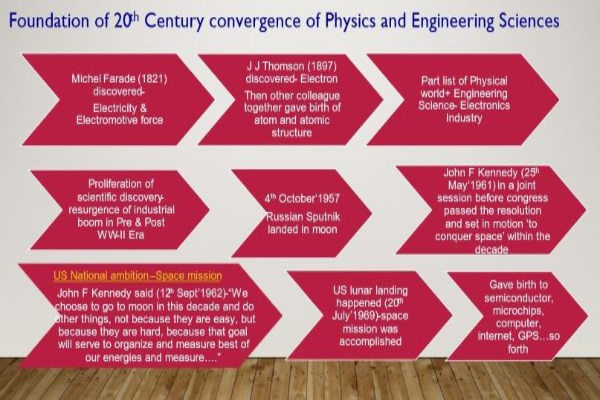
Fig-2: Convergence of Physics and Engineering Sciences
It is a universal truth that no one knows what the world of tomorrow will look like, which trends will prevail and which products will be in demand? Futurologists are using scenarios to help companies prepare for a variety of hypothetical developments and develop appropriate strategies in advance. Companies must gain the confidence to accept that what is self-evident today may not be self-evident tomorrow and hence leadership to break the large whole into smaller pieces and then delve into future----.
Now to deal with the uncertainties hinges on to India and other nations from the ongoing Russia-Ukraine war has created a profound case and an urgency for a nation like India to orchestrate the national foresight in the form of a master plan, renewed in every 3-5 years for chemicals by engaging best brains of the nation from 360 degree capabilities (Political analyst, economists, social scientists, legal expert, bankers; chemical, biological, physical, environmental & material scientists; Engineers of all discipline, medical practitioners, eminent academicians, mix of entrepreneurs from different age bracket, forward looking industrialists, global consultants of international repute. This vision will be incomplete unless steered by two visionary leaders who have been great narrators on current global best trend, ought to be eminent persons who are hungry (e.g Personality like Dr. Manmohan Singh & Nandan Nilkeni of chemicals) to give the direction, lay the foundation for building advanced capabilities like what has been done for space technology in India. They should pen-down the future vision of chemicals for India, prescribe intricacies involved (1). To build talent pool for India (2). Create modern infrastructures with state of art R&D facilities in a cluster model (e.g IIT Madras Research Park and add-on capabilities) in every region (East, South, North, West) with world class facilities (3). Laying out partnerships model for high end collaboration to ‘Deliver benefits from research’, ‘Develop STEM talent for India’, ‘Expand geography of innovation’, ‘Foster a global S&E community’ and build technology of future aiming successful landing in 2047, which happened to be the centenary of India’s Independence.
Government, Industry and Academia to work Independently, or as cohorts, or in partnership in public, private, Institute of eminence, universities, government funded laboratories or in combination. Government, captains of industry ought to invest/sponsor as a percentage of turnover to give boost in ‘Fundamental Research’, ‘Basic Research’, ‘Applied Research’ and ‘Experimental Development’ on priorities set for the nation and stated in vision; continue monitoring progress from Govt of India at highest level, accelerate the pace discovery-to-innovation cycle; file patents, create new IP’s of new generation on knowhows in tens of thousands and to build licensable technologies of future in chemicals in India and then for the world allow capital to flow in R&D in the direction and compositions as shown in Figure-3.
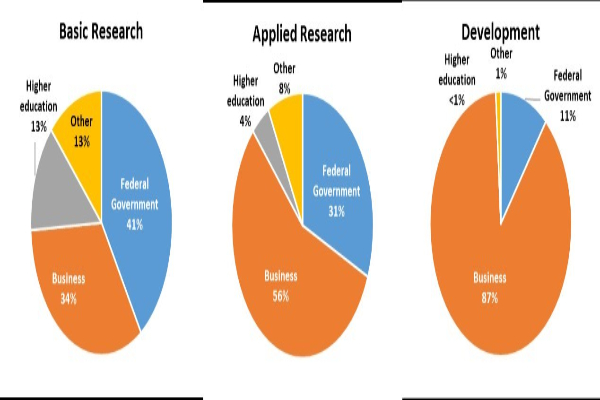
Fig -3: Composition of U.S. Basic Research, Applied Research, and Development by Funding Sector, 2020
For a private enterprise owner who will envision into the future, wanting to grow seamlessly ahead of competition curve targeting global foot-print willing to create ‘built-to-last’ company for decades to come, should design composition of board for enabling foresights, ought to be as if the competition is discerning in the board room and practice detachment from close aides as a principle for breeding transparency with a vision to go global, bring prosperity to the organization and the nation where new-age thoughts on challenging themes are encouraged, debated and envisioned & created for phenomenal lasting growth; set cultures in motion adhering the principles of quantum mechanics for transforming company from a Red-ocean market place to the next higher level into ‘Pushing the boundary’ market and then honing for the market of ‘Breaking the boundary’ space by way of creating augmented products & services that are difficult to imitate by any company on earth, a sort of perpetuality sets in. Firms should imbibe philosophy where professionals with high integrity and a selfless person designed to serve the nation, community at large ought to run the show to repose/solidify faith in customer’s mind and all other stakeholders of the company, else it may die down sooner or later. Value innovation map depicted below may be of some help for budding entrepreneurs (not designed for established business person) who wish to create organization of future may become a handy approach to them given below (Ref fig-4).
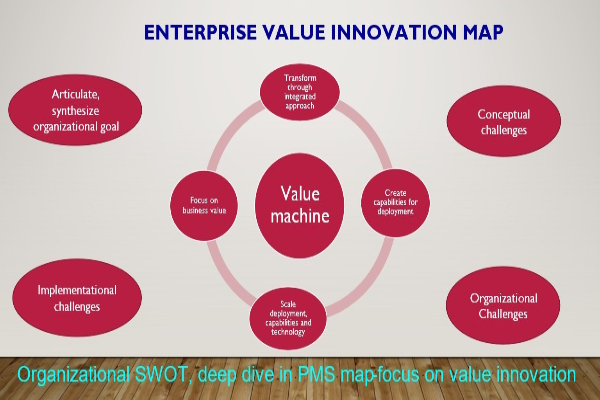
Fig -4: Enterprise value innovation map
The nature of probability is such that even improbable things can happen, according to Aristotle. More than 2,000 years later, this realization is more relevant than ever.Today our lives are being shaped by innovations whose existence we would not have thought possible a short time ago. We, the nation of India to join hands with the leading scientists from the globe work together on bold insights into the world of tomorrow, examine how probability of a successful future is growing and then build solutions to capitalize on opportunities getting created.
There is a thought that in future there will be two groups who will govern the society--Innovators, Entrepreneurs, Scientists, and they will govern the other; the key thing is education, technology will go forward and it will never be backwards and hence educate people, build capabilities.Research and Development (R&D) comprise creative and systematic work undertaken to increase the stock of knowledge including knowledge of humankind, culture, and society and to devise new applications of available knowledge where future investment to flow. Any activity to qualify as R&D should pass through following hurdles and it must satisfy five core criteria:
-Novel
-Creative
-Uncertain
-Systematic
-Transferable and/or reproducible.
Types of R&D (Basic research, Applied-research, Experimental Development) in chemicals with a brief of it is given below for better clarity of thought and for planning on assigning projects according to the focus and for provide right kind of resources from beginning help in creating, filing patents for acceptances internationally. R&D gives an indication of scientific progress a company or nation is making progress by pulling optimum resources in researches happening in the territory:
Basic research-Basic research is experimental or theoretical work undertaken primarily to acquire new knowledge of the underlying foundations of phenomena and observable facts, without any application or use in view.
Applied research-Applied research is original investigation undertaken to acquire new knowledge. It is, however, directed primarily towards a specific, practical aim or objective.
Experimental development-Experimental development is systematic work, drawing on knowledge gained from research and practical experience and producing additional knowledge, which is directed to producing new products or processes or to improving existing products or processes. Further deep dive into the US R&D funding by character of work and facilities and equipment characters, segmental distribution, and magnitude to lay emphasis where India needs to push for R&D and portfolio which will delve in building India’s sovereignty on chemicals.
Whether a company operate in a technology intensive businesses like pharmaceuticals or electronics, or a more traditional manufacturing sector like automobiles, company growth in a highly competitive world hinges on superior R&D performance. And yet, no other endeavour frustrates management more, than attempts to improve R&D performance. Many R&D organizations have endured repeated restructuring, oscillations between centralized to decentralized models, endless process re-engineering, a barrage of team concepts, and a host of other management interventions with little to show for it.
Probable pathways on R&D: For companies who are in dilemma but planning to venture into a new R&D project aiming at futuristic growth or solving industry specific problem, below themes may augur better outcome and will provide valuable direction worth taking for narrowing on choices. A good strategy for a new comer would like to take, adopt three essential elements as a guide like consistency, coherence, alignmentwith right purposes (requirements) as a process and maintain, have better chances of winning from onset of conceptualization to attainment of progressive milestones.
For growth of Indian chemicals entire ecosystem ought to work on a larger theme “Do, what others don’t dare to do” in areas where spirit of high-end entrepreneurship aiding, enabling key resources from government will be essential to develop core technologies in the tertiary products & services where India is largely depending on import. Western world is vying for capturing Indian market as demand is set grow in multiples. Add on to it, further examination of UN SDG portfolio’s translation give rise to new product needs will set to emerge; give answer what type of chemicals country need, which value added products the economy should be looking for coming decades. The list below is illustrative only
1. Green energy materials-
• Wind turbine-requires light-weight materials
• Solar energy- PV cells, storage battery, transmission line cables
• Green hydrogen- Equipment for transport, high pressure pipelines
2.Electronics materials- TV LCD, LED, electronics chemicals, security camera, mobile phone, optically transparent, electro coating materials, fast EV charging kit
3. Computer & Information technology materials- PC Chassis, mouse, TFT panel, routers, Lan cable, PC power adapters
4. Electric vehicles materials- Batteries, light weighting polymer, composites materials, interiors, panels, acoustic insulation
4. Film & film products materials - high-capacity imaging films
5. Advanced composites material-Air craft, high speed cars
6. Light & heat blocking materials
7. Auto mobiles- It is a new world of Material Sciences; scope of innovation is unlimited.
8. Medical imaging & testing equipment- MRI, CT-Scan, X-Ray optics, Photo chromatic eye lens, dialysis equipment
9. Health care materials- Cosmetics, skin care, disinfectant, floor cleaning chemicals etc
10. Water recycle materials- membrane chemicals, water treatment etc
11. Textile & apparel- Weather resistant clothing chemicals, sports-wear, Leasure fabrics, clothing to protect against infection
12. Pharmaceuticals- sustainable medicine
13. Agrochemicals- Sustainable pesticides, biocides, insecticides, herbicides, organic crop farming chemicals.
To support rising demand on products expected to come from life style change, make in India campaign will require indigenous manufacturing capability based on indigenous technology to bring down the price to make products and available to large masses which will enable to bring down overall cost of living. To attain this larger theme, Process & Product develop technologies will have to be indigenized and these steps below will help to increase the probability of success more in that direction.
Once we have firmed up on the blue-print to commence work on bench-scale study for a novel discovery requires multiple routes screening with uncertain outcomes, limited choices we need to arrive at from the bundle of conflicting approaches, it is better that we may take side of process synthesis as a guiding principle for making timely progress, minimize uncertainties.
Bench scale briefs
Bench-scale synthesis is where the journey begins. In research labs, scientists/engineers explore new synthetic pathways, experiment with reaction conditions, and refine their understanding of the chemical processes involved. These experiments often start with small quantities of reagents with a scale (50-250 gm, 250-500 gm) depending on the outcome from meticulously controlled environment to ensure reproducibility. Successful laboratory-scale synthesis sets the stage for further development and then go for successive steps to reach into the scale-up stage.
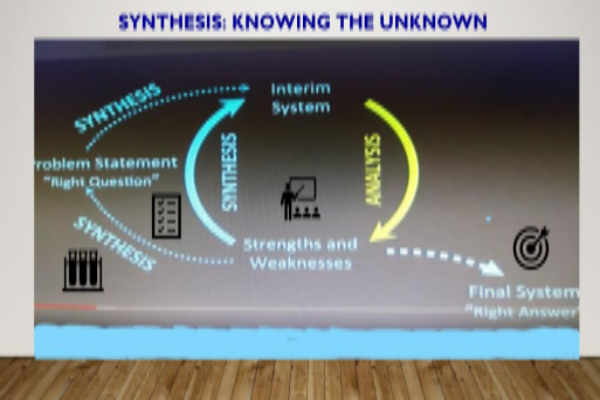
Fig -5: Inter play of Synthesis & Analysis on process engineering design
It is often said that it would be much simpler, easier if we invest good amount of time again from the bench scale learning, observations to conceptualize, debate before we start working on the main theme to a pilot plant where intense process led activity is desirable. An working sketch on chemicals provided in (Fig-5)will be very handy and the chances of success expected to be better while making incremental progress in pilot plantperformance assessment scale of (10-50 kg’s,100-500 kg’s) and the next would be to going for a demonstration plantfor novel process where large scale operating experience has not been tested to translate into a full-fledged mega commercial plant for optimizing process, strengthening process safety and to minimize Opexand Capex for a sustainable and licensable technology of future.
To incorporate new properties into advance polymeric materials, formulation from a broad class of polymers through new chemistry on materials research, polymer formulations with inorganic particles, such as graphene, silver or carbon nanotubes,carbon or glass Fibers infusion in polymer matrix can create high-performing composites etc will have to be undertaken in the emerging chemistry for specific application of material in future, requires capability building from lab to pilot and finally into commercial scale-ups. Range of specialty polymers out of many are listed below
Biodegradable Polymers: polylactic acid (PLA), polyglycolide (PGA), polylactide-co-glycolide (PLGA), polycaprolactone, Poly (glutamic acid), poly (benzyl glutamate), etc.
Water-soluble polymers: Poly (vinyl alcohol) (PVOH), Poly (acrylic acid) (PAA), Poly (vinyl acetate) (PVAc), Poly (vinyl pyrrolidone) (PVP), Poly (viny imidazole) (PVIm), Poly (acrylamide) etc.
Polymeric salts: Poly (vinyl imidazolium), Poly (vinyl pyridinium), Poly (diallyl dimethyl ammonium), Poly (styrene sulfonate) etc.
Functional polyether from Poly (ethylene oxide) (PEO / PEG), Poly (propylene oxide) (PPO / PPG), Polytetrahydrofuran (PTHF, PTMEG), etc.
Functional rubbers such as polybutadiene (BR), polyisoprene, polysiloxane, polysilazanes, etc.
Fluoropolymers: PTFE, PVDF, PFPE, PFA, FEP, (P (VDF-HFP), etc.
Thermostable polymers: Polyetherketone (PEK), Polyetheretherketone (PEEK), Polyetherketoneketone (PEKK), Polyetherimide (PEI), Polyethersulfone (PES), Polymer of intrinsic microporosity (PIM), etc.
Silicones: Hydrophobicity and toughness
Optical polymers: high refractive index, low refractive index, fluorescent, NLO polymers
For this a bunch of new technology portfolio will have to be created, augmented to innovate process and product technologies utilizing existing fundamental domain-technologies namely- Computational science, Organic synthesis, Process technology, 3-D Printing, Informatics & data science, Artificial Intelligence for enhancing the capabilities of core technologies and precision in product design e.g Organic synthetic chemistry, Polymer Chemistry, Surface Control Technology, Dispersion Control Technology, Applied Optics, Bio-technology, Nano technology, Innovative material design, Film processing technology, Fibers & Textiles, Microstructure Technology, Medicinal Technology, Gene Utilization Technology, Fermentation Technology, Membrane technology, Poly olefins, Adhesion Technology, Engineering Plastics, Coating & Printing Technology.
Therefore, the vision definition of a nation like India ought to be re-orchestrated with a conviction repeated once again here what John F. Kennedy stated in 12th September’1962 “We choose to go to moon … in this decade and do the other things, not because they are easy but because they are hard; because that goal will serve to organize and measure the best of our energies and skills, because that challenge is one that we are willing to accept, one we are unwilling to postpone, and one we intend to win, and the others, too.” to create products from indigenous technology with built-in credibility to license, challenge the existing licensable technologies, capitalizing disrupting technology ideas, synthesizing fusions of emerging technologies embedded into chemical process & product development arenas which no other country has attempted, emerging science to be made discernible to create new synthetic routes in chemistry, material science formulation utilizing power of overlap of Science & Engineering (S&E), design new flow-sheets by applying combinatorial science to amalgamate multiple unit operations, downsizing equipment piece counts, enabling bio-engineering processes embedded into the design, mimicking human physiology concepts to bring down the overall energy foot-print on process and product development, build recyclability into the process so that usage of chemicals by human should improve sustainability concerns of people and the planate.
On a concluding note, India needs to attain heightened success in R&Din Science & Technology, STEM required to navigate on a broader theme of building solitude, calmness in growing age starting from childhood and then from primary education; create a space for silence, solitude in society because it brings tranquillity in mind to attain a of cult retentivity and help in building capabilities of high energy. This will produce talent of high quality, enhance productivity, increase discovery with higher strike rate in Research& Innovation. Indian did not inherit distraction, nor it was in our culture but it was injected in our mainstream by Invaders and then by foreign rulers as a result desired progress did not happen. Therefore, we must rebuild higher level of capabilities and strengthen our core to secure our coveted future. Remember a Stealth jet bomber is many times more capable than any traditional aircraft bomber.
Let leadership of India and its larger fraternity to act fast, deliver the dream for 1.4 billion aspiring Indians.
(Disclaimer-This article of mine is written based on the limited understanding I have in my personal capacity, backed by reading literatures from open source, enriching interactions I have with people from various fields over the years but not limited to technical, rather many sections of society and framing ideas cumulatively from my natural space linking importance of chemicals and its uses in our daily life; harnessing conceptual foot-print and experience I have accumulated in Chemical Engineering field, relating disruptive changes happening after covid in the global economy and its ripple effect affecting chemicals business globally. Haldia petrochemicals is in no way responsible or tied to any of the facts, context etc provided on the core issues that I tried to articulate thinking it would be helpful to some who wish to invest in chemicals and have passion to take the journey forward. This article is primarily intended for knowledge sharing so that the larger ecosystem of India can get benefitted in the process get a value-added insight on the core of R&D and issues they had to deal with for embarking on this challenging field throwing bundle of opportunities of growth in coming decades).
Subscribe to our newsletter & stay updated.